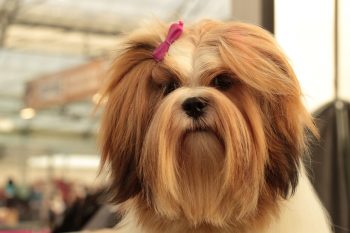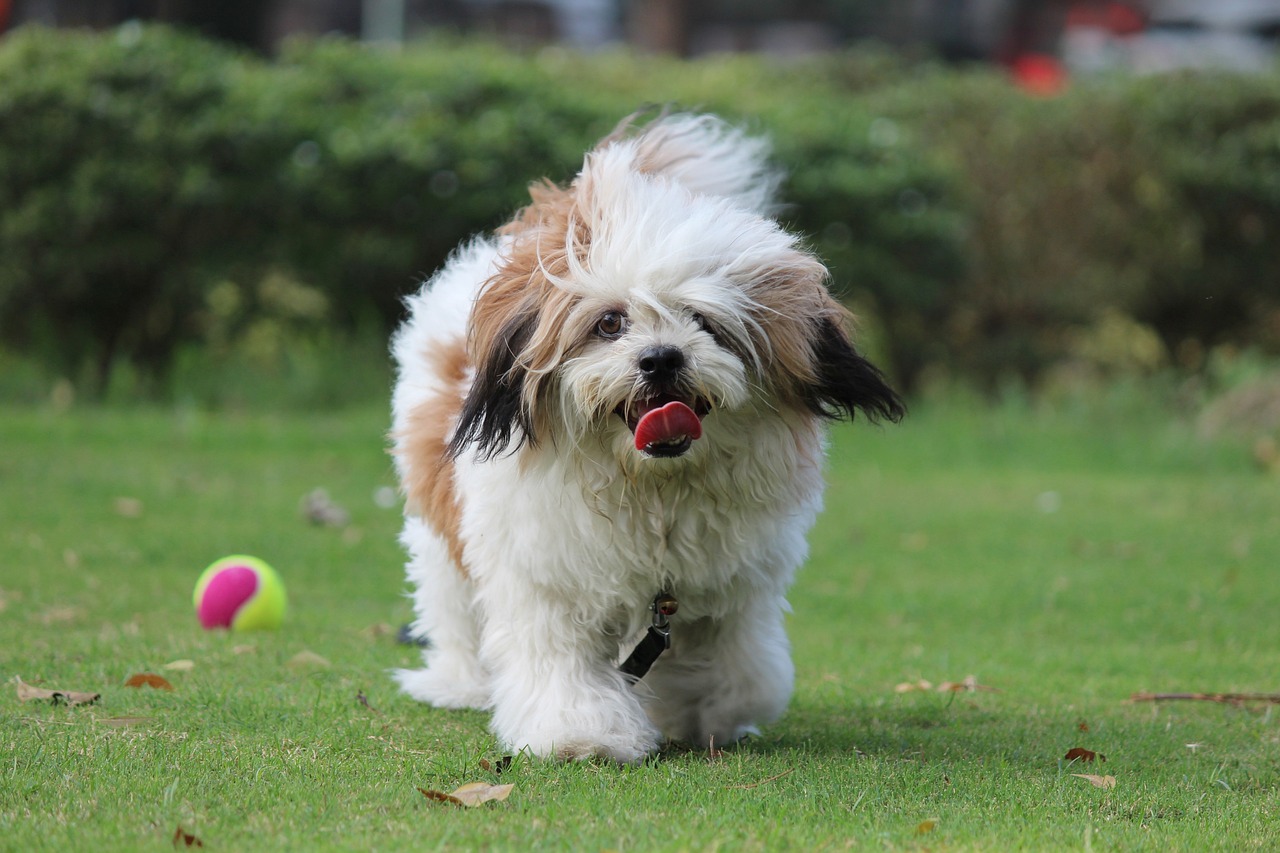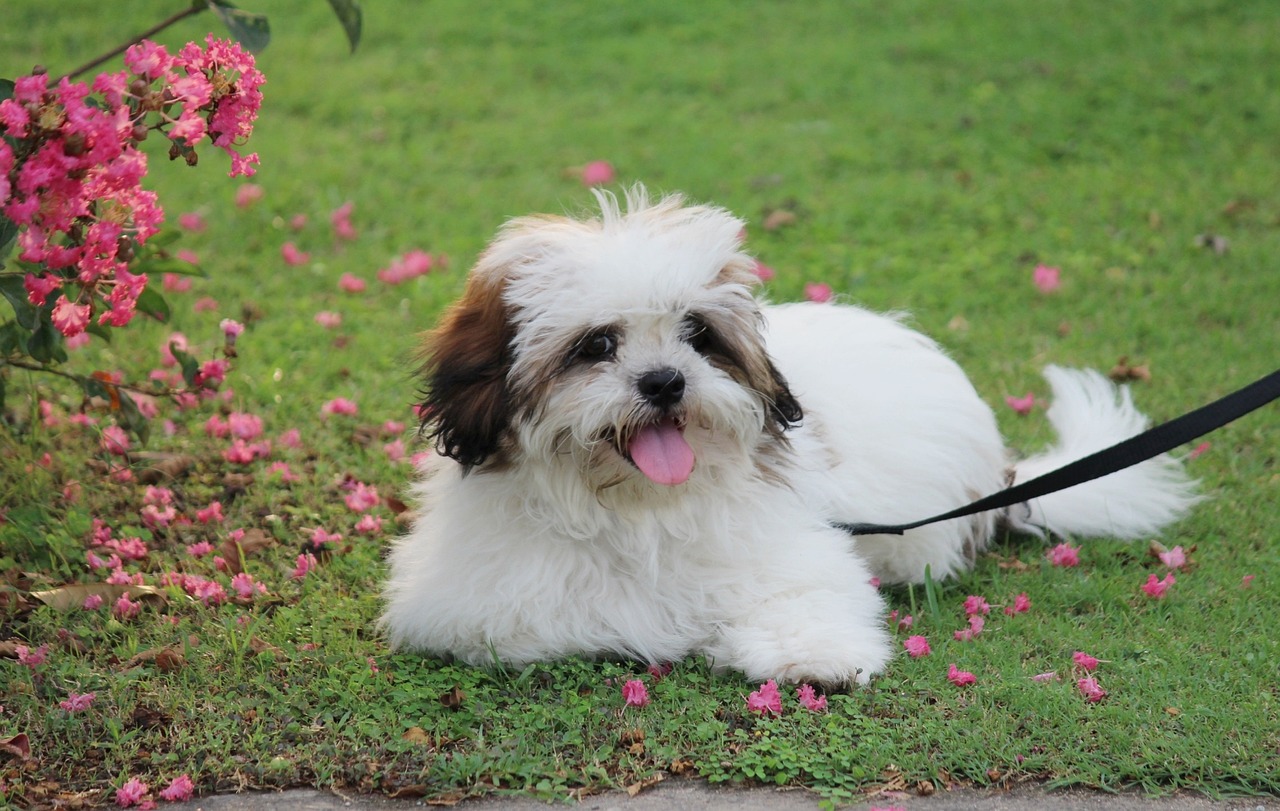
The Lhasa Apso, a breed steeped in mystery and ancient tradition, hails from the mystical heights of the Himalayas in Tibet. Known for their long, flowing coats and keen sense of hearing, Lhasa Apsos were originally bred as sentinel dogs in Tibetan monasteries and noble homes, where they served as alert guards at high altitudes. Their name, “Lhasa,” refers to the sacred city of Lhasa, while “Apso” is a term from the Tibetan language meaning “bearded,” reflecting the breed’s distinctive long and heavy coat. For centuries, these dogs were regarded as sacred, believed to be the reincarnations of lamas, the Tibetan spiritual teachers. The breed’s history is intertwined with Tibetan Buddhism and lore, contributing to its mystical reputation. Gifted only to those deemed worthy of such an honor, Lhasa Apsos were not sold but given as tokens of esteem and good fortune, making their way out of Tibet only with great difficulty. This article delves into the rich history and origin of the Lhasa Apso, exploring its development, cultural significance, and the enduring legacy of this ancient breed.

The Ancestral Origins of the Lhasa Apso
The Lhasa Apso’s origins can be traced back over a thousand years, making it one of the oldest recognized dog breeds in the world. These dogs were bred and raised within the isolated confines of Tibetan monasteries, where they were believed to serve as companions to Buddhist monks and as protectors of the temples. Their role extended beyond mere companionship; they were considered sacred, with a spiritual significance tied to their presence. The breed’s keen sense of hearing made them excellent watchdogs, alerting monks to any intruders or dangers. The harsh climatic conditions of Tibet also influenced the Lhasa Apso’s physical development, resulting in a breed well-adapted to the cold, with a dense, long coat that protected them from the elements.
Development and Recognition
The Lhasa Apso remained a well-kept secret of Tibet until the early 20th century, when the breed began to make its way to other parts of the world, primarily through gifts to foreign dignitaries and visitors to Tibet. One notable introduction of the breed to the Western world was by C. Suydam Cutting, who brought the first Lhasa Apsos to the United States after a visit to Tibet in the 1930s, a gift from the 13th Dalai Lama. The breed was officially recognized by the American Kennel Club (AKC) in 1935, categorized under the Terrier group before being reclassified to the Non-Sporting group in 1959. In the United Kingdom, the breed’s recognition came somewhat later, with The Kennel Club registering the Lhasa Apso in 1971.
The Breed in Modern Times
Today, the Lhasa Apso is cherished worldwide as a companion dog, admired for its independent spirit, loyalty, and unique appearance. Despite its small size, the breed is known for its confident and assertive demeanor, often described as a small dog with a large dog’s personality. Modern Lhasa Apsos retain their ancestral traits of vigilance and alertness, making them excellent watchdogs. They have also found success in various dog sports, including obedience and agility, showcasing their intelligence and versatility.
Characteristics and Temperament
The Lhasa Apso is characterized by its long, flowing coat, which comes in a variety of colors, including gold, sand, honey, dark grizzle, slate, smoke, black, white, or a combination thereof. Their expressive eyes and beard add to their distinctive appearance, embodying the “bearded” aspect of their name. Temperamentally, Lhasa Apsos are known for their independent and sometimes aloof nature, showing affection on their terms. They are loyal to their families but may be wary of strangers, a trait that harks back to their days as temple guardians. Proper socialization is key to ensuring they grow into well-adjusted adults.
The Lhasa Apso’s journey from the sacred temples of Tibet to the hearts of dog lovers around the globe is a testament to the breed’s enduring appeal. These ancient dogs, once guardians of Buddhist monasteries, continue to captivate with their unique blend of spiritual significance, distinctive looks, and spirited personality. Their history, deeply rooted in Tibetan culture and spirituality, adds a layer of mystique to the breed, making the Lhasa Apso not just a pet, but a living link to a rich, ancient heritage. As they adapt to modern life, Lhasa Apsos maintain the dignity and grace that have been their hallmark for centuries, ensuring their place as cherished companions for years to come.
Frequently Asked Questions About The History of Lhasa Apsos

1. What is the origin of the Lhasa Apso breed?
The Lhasa Apso originated from Tibet, specifically from the city of Lhasa, where it was bred and raised within the sacred walls of Buddhist monasteries. These dogs were highly revered and served as both companions to the monks and guardians of the temples. The breed’s history dates back over a thousand years, making the Lhasa Apso one of the oldest dog breeds in existence. Their primary role was to act as sentinels, using their acute hearing to alert monks of intruders. The harsh, mountainous landscape of Tibet also contributed to the breed’s development, resulting in a dog well-adapted to cold temperatures with a long, dense coat.
2. Why is the Lhasa Apso considered a sacred breed in Tibet?
In Tibetan culture, the Lhasa Apso is considered sacred due to its close association with Buddhist monasteries and its role in protecting sacred sites. The breed was believed to embody the souls of departed monks, serving as a spiritual bridge between the physical and metaphysical realms. This belief stems from the Buddhist concept of reincarnation, where the Lhasa Apsos were thought to house the souls of lamas seeking rebirth. Consequently, these dogs were treated with great reverence and were often given as gifts to honor and bestow blessings upon the recipient.
3. How did the Lhasa Apso get its name?
The name “Lhasa Apso” directly references the breed’s origins and physical characteristics. “Lhasa” is the capital city of Tibet, indicating the breed’s geographic origin, while “Apso” is a term from the Tibetan language that translates to “bearded.” The name essentially means “long-haired Lhasa dog,” highlighting the breed’s distinctive flowing coat and its connection to the city of Lhasa. The term aptly describes the breed’s appearance and ties to Tibetan culture and heritage.
4. When did the Lhasa Apso first come to the Western world?
The Lhasa Apso was introduced to the Western world in the early 20th century. The first notable introduction occurred in the 1930s when C. Suydam Cutting, an American traveler and naturalist who visited Tibet, brought the first Lhasa Apsos to the United States as gifts from the 13th Dalai Lama. This marked the beginning of the breed’s presence outside of Tibet, initially as exotic gifts to dignitaries and later becoming popular among dog enthusiasts in the West.
5. How was the Lhasa Apso breed preserved during times of turmoil in Tibet?
During times of turmoil in Tibet, including the Chinese invasion and subsequent cultural upheavals, the Lhasa Apso breed faced the risk of extinction. Preservation efforts were undertaken by Tibetan monks and breed enthusiasts who managed to smuggle some of these dogs out of Tibet to neighboring countries and, eventually, to the West. These efforts, combined with the breeding programs established by Western dog enthusiasts who had received Lhasa Apsos as gifts, helped preserve the breed’s lineage and characteristics during a period when its survival was uncertain.
6. What are the traditional roles of the Lhasa Apso in Tibetan culture?
Traditionally, the Lhasa Apso served multiple roles in Tibetan culture, primarily as guardians of Buddhist monasteries and as companions to monks. Their keen sense of hearing made them excellent watchdogs, alerting the monks to any intruders or dangers. Additionally, their sacred status meant they were also symbols of good fortune and spiritual protectors. The Lhasa Apsos were believed to bring blessings and were often given as precious gifts to promote good health and prosperity.
7. What distinguishes the Lhasa Apso from other Tibetan dog breeds?
The Lhasa Apso is distinguished from other Tibetan dog breeds by its smaller size, long, flowing coat, and distinct “bearded” appearance. Unlike the Tibetan Mastiff, which is a large guardian breed, or the Tibetan Terrier, which has a more shaggy coat, the Lhasa Apso is characterized by its luxurious hair that covers the eyes and body and its relatively small but sturdy build. The breed’s unique combination of physical traits and its specific role as a sentinel and companion within Tibetan monasteries set it apart from other native breeds of the region.
8. When was the Lhasa Apso officially recognized by kennel clubs?
The Lhasa Apso was officially recognized by the American Kennel Club (AKC) in 1935, shortly after the breed was introduced to the United States. This recognition allowed the Lhasa Apso to participate in AKC-sanctioned events and helped standardize the breed’s characteristics for show and breeding purposes. In the United Kingdom, The Kennel Club recognized the Lhasa Apso somewhat later, with official recognition coming in 1971. These milestones were crucial in establishing the Lhasa Apso’s presence and popularity in the dog show world and among pet owners outside of Tibet.
9. What are the key physical characteristics of the Lhasa Apso?
The key physical characteristics of the Lhasa Apso include its long, dense, and flowing coat, which comes in a variety of colors such as gold, cream, honey, dark grizzle, slate, and smoke. The breed has a sturdy, compact body, with a well-proportioned head, dark, expressive eyes, and a heavy feathered tail that curls over the back. One of the breed’s most distinctive features is its “bearded” appearance, with long hair covering the face and hanging down from the chin, which adds to its noble and dignified look.
10. How has the Lhasa Apso’s role changed from ancient times to today?
While the Lhasa Apso’s role in ancient Tibetan culture was primarily as a monastery and home guardian, today, the breed is primarily cherished as a companion animal. The transition from guardian to companion reflects changes in the breed’s living conditions and the needs of its owners. Modern Lhasa Apsos still retain their alert and watchful nature, making them excellent watchdogs, but their primary role has shifted to that of a loyal and affectionate family pet. Their adaptability and charming personality have endeared them to dog lovers around the world, transcending their ancient protective duties.
11. What is the temperament of the Lhasa Apso?
The Lhasa Apso is known for its confident, independent, and sometimes aloof temperament. The breed exhibits a strong sense of self and can be reserved, if not properly socialized, but is also known for its loyalty and affection towards its family. Lhasa Apsos are intelligent and can be playful, enjoying interactive games and activities. Despite their small size, they have a bold and assertive nature, often standing their ground and alerting their owners to strangers or unusual occurrences. Early and consistent training and socialization are key to harnessing their best qualities and ensuring they are well-adjusted pets.
12. How do Lhasa Apsos interact with children and other animals?
Lhasa Apsos can interact well with children and other animals if they are raised together or properly socialized from a young age. Their playful and affectionate nature can make them good companions for children, though their independent streak means they may not tolerate rough handling. As with all breeds, interactions between Lhasa Apsos, children, and other pets should be supervised to ensure they are positive and safe. Proper introductions and socialization help Lhasa Apsos understand how to interact appropriately with other animals and respect boundaries.
13. What are the grooming requirements for a Lhasa Apso?
The grooming requirements for a Lhasa Apso are relatively high due to their long, dense coat. Regular brushing, at least a few times a week, is necessary to prevent mats and tangles. Many owners opt to keep their Lhasa Apsos in a shorter “puppy cut” to reduce grooming needs. In addition to coat care, regular nail trimming, ear cleaning, and dental care are important for maintaining their overall health. Professional grooming every few months can help keep their coat in good condition and manage any grooming challenges.
14. How long do Lhasa Apsos typically live?
Lhasa Apsos have a relatively long lifespan, typically living between 12 to 15 years. Some individuals may live even longer with proper care, including a balanced diet, regular exercise, and routine veterinary check-ups to manage and prevent potential health issues. Their longevity is a testament to the breed’s hardiness and the care provided by their owners.
15. What health issues are common in Lhasa Apsos?
Lhasa Apsos are generally a healthy breed but can be prone to certain health issues, including hip dysplasia, patellar luxation, and various eye problems such as cherry eye and progressive retinal atrophy. They may also experience skin problems due to allergies and sensitivities. Regular veterinary care and health screenings can help identify and manage these conditions early. Responsible breeding practices are crucial in reducing the risk of hereditary health issues in the breed.
The post The History and Origin of the Lhasa Apso: A Comprehensive Look appeared first on iHeartDogs.com.
via Whisker Therapy